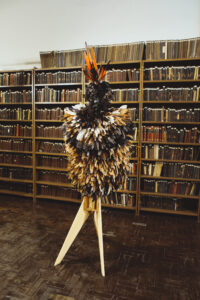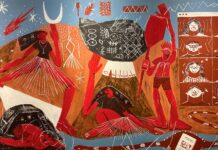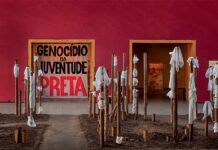Nthe 60th Venice Biennale, in Italy, from April 24th next year, the
Brazil will be represented by a work by the visual artist, filmmaker, writer,
Bahian anthropologist and researcher Glicéria Tupinambá, known as Célia
Tupinambá. Célia will take the exhibition to Venice Ka'a Pûera: we are
birds that walk, by Glicéria Tupinambá and guests, curated
by Arissana Pataxó, Denilson Baniwa and Gustavo Caboco Wapichana. Ka'a
Pûera is the name for a large area of forest that is in the process of being
regeneration after a fire or use as crops or pasture.
The exhibition in Italy also foresees that the Brazilian Pavilion in the Giardini della
Biennale be renamed Hãhãwpuá Pavilion (Pataxó name that was
used to describe Brazil before the Portuguese sighting). According to
Fundação Bienal de São Paulo, the exhibition by Célia Tupinambá to be installed
in Italy addresses “issues of marginalization, deterritorialization and rape
of territorial rights, inviting reflection on resistance and the essence
shared humanity, birds, memory and nature”, which integrates
to the general theme of the 60th International Art Exhibition – La Biennale di
Venice: Foreigners Everywhere (Foreigners everywhere).
Born in 1982 in the Tupinambá village of Serra do Padeiro, in Olivença, in the south of Bahia, Célia is a master's student in Anthropology at the Federal University of Rio de Janeiro and headed the negotiations to repatriate to Brazil, in 2024, the Tupinambá Cloak which is currently in the National Museum of Denmark, in Copenhagen. During the colonization of Brazil, the cloaks of the Tupinambá became objects of barter, looting or negotiations, and their construction technology was lost in time. She relearned how to make the cloak, becoming the first woman to construct such an artifact in more than 400 years.
On the 25th and 26th of November (Saturday and Sunday), the ZUM Festival, organized by the Instituto Moreira Salles photography magazine, will bring together artists, photographers and researchers for conversations, workshops, exhibitions, fairs and other free activities. The event, which is in its 8th edition, takes place at the IMS headquarters in São Paulo (Av. Paulista, 2424), and will highlight an action by Célia Tupinambá, on the 25th (Saturday), at 14pm. She will lead a collective walk, with Manto Tupinambá, through the spaces of
IMS, accompanied by representatives of other indigenous Nations. Glicéria Tupinambá gave the following interview to arte!brasileiros:
ARTE!✱ - The IBGE Census, recently released, reported that the indigenous population in Brazil today represents 0,83% of the total number of Brazilians, around 1,7 million people. And it is a very diverse representation, there are groups with 12 individuals and others with 20, 30 thousand people. Is it too complicated to go to Venice representing all this diversity?
It depends on what point of view you're talking about. Because, if you think that Brazil is indigenous territory, and if you think that this percentage that IBGE raised, trying to demarcate this presence, these populations trying to resist, trying not to be swallowed... Well, I'm going to represent the indigenous people. But it has an immense partnership with other Indigenous Nations, such as Denilson Baniwa, who is from Amazonas; Arissana Pataxó, who is from Bahia, Gustavo Caboco, who is Wapixana, from Roraima. It is a very intense geography, territorially. Occupying these spaces puts the population
indigenous people in evidence, makes it clear that indigenous peoples are being swallowed up by a very aggressive dynamic. Help them see the indigenous presence.
ARTE!✱ - Next week, you will show the Tupinambá Manto that you made at the Moreira Salles Institute, on Avenida Paulista, in São Paulo. What is the importance of the Tupinambá Mantle in these itineraries? For this activity I am inviting relatives. So there's Pankararu, Pankararé, Guarani, Tukano. The mantle brings this space for dialogue and rupture, we tend to encounter tensions, challenges. And it's not just Célia Tupinambá, it's a historical burden, and these alliances, this being with relatives (serves) to see what situation they are in, what places they are. So, it is important and fundamental that the presence of the mantle makes people think, re-elaborate other conceptions. Being with relatives, because of possible dialogues, is important, just as it is important for the mantle to be in movement so that people can understand another logic. The Manto is a provocative body.

ARTE!✱ -You made the first Manto Tupinambá in 2006. That's 17 years ago.
How many more did you do after that first one?
I made two more. The one I'm going to present now is the female cloak, there's a difference. The first one I made from an image, an image I saw of the mantle that is in Denmark. So it's an approximation, you couldn't see the plot, it was too full of feathers. In 2018, when I saw a cloak in France, and soon after, another cloak in Switzerland, in Basel, I started trying to understand the mesh. There is a cloak there in Basel that is more worn, you can see the mesh perfectly. My idea was to understand the heart and bone of the mantle. I previously tried to get my great aunts to teach me their
way to make the cloak. But they told me that, as I had already dreamed of the mantle, I already knew how to do it, there was nothing to teach. So I took their advice and made the first cloak, which is now in the National Museum in Rio de Janeiro. It was incorporated from the traveling exhibition Os Primeiros Brasileiros, curated by João Pacheco de Oliveira, in 2021. In 2020, I made the second mantle, which was for my brother, who is chief Babau of the Tupinambá people. It was then that the cloak told me that it was made by women. When that happened, I was left with this “cosmo-agony” (laughs). I didn't have what people call “evidence”, I only had this authorization from the Enchanted. So I went after it. Afterwards, Fernanda Liberti (photographer and visual artist) arrived in the village and brought me a book called The River Before the River, by Rafael Freitas Silva (Editora Relicário, 2021). On the cover of this book there is a woman in an illustration, a woman wearing the cloak with a child on her back. It's a woodcut. This image, of the woman wearing a cloak, I later looked at three other drawings again. In another drawing, she wore the cloak, skirt and maraca. Later on, (anthropologist) Daniela Alarcon and I ended up finding this material. But there was still little trace. In 2022, when I was in Denmark, the mantle spoke to me.
ARTE!✱ - Does the cloak speak to you when you are near it?
When I'm around him, he talks to me, and he told me he was feminine. I already had this proof, having seen the cloak being used by six to seven women, and each texture of the cloak was different. In 2023, I was at the Palace of Versailles, in France, and in the Royal Hall we saw this illustration of a work that represented the continents. On the South American continent there was a woman wearing the Tupinambá Cloak. The people who were with us said to me: “Ah, Célia, but this cloak has a Greek touch”. And I said, “Does that change the fact that it’s a woman?” In the imagination of Hans Staden (1525-1576), the cloak is only used by shamans, and we know that it was also used by chiefs. It is the shaman and the Tupinambá society around him and the mantle. But when we found these images, we came full circle to six women wearing the cloak. The last one was on the map I saw of Atlantic France, which has an illustration with another woman wearing the cloak. Then I realized that the cloak was feminine.
ARTE!✱ - How many Tupinambá Cloaks are there in the world today?
There are 11 mantles. They are in Brussels, Copenhagen and Basel. There are also many Tupinambá objects in the cabinets of curiosities. In France, there is an axe, a club, a hammock. That week in Versailles was very intense, we saw a lot of things in France, and the Tupinambá memory was very strong. It was then that I had this confirmation of how the Tupinambá people were received. In the historical narrative, we never had a political place of equality, but the various representations of indigenous people that I could see, and one of them is an exclusive fresco, things that we had never seen, demonstrate that there was an alliance and respect. The story told in Brazil about the Tupinambás has another aspect, making our presence invisible. For people to understand why these European cloaks are in the possession of kings in Europe, they need to know that this happened because it was an alliance from king to king. People say a lot of things, but you need to understand this continuous thread.
ARTE!✱ - Originally, the cloak was made of maned feathers. But this is no longer
possible today, right?
Thank God, there are still maneds. And now, the guarás have arrived in Bahia, there is a city called Salinas that has a mangrove that has guarás. But the cloak I made, I made with the macaw feathers that were there at my disposal. The birds leave their feathers for me, there's no need to kill them, they change their feathers every year. I use the ones I have on hand: bone-billed thrush, sparrowhawk, forest canary, inhambu, tuurim. Just now I received hundreds of Guará feathers from an artist in a quilombo. Once we learn the knot, the mesh, the guiding thread, anything is possible. It is not a replica. It’s about understanding this complexity, because that makes the thread understandable. You need to internalize, listen. In general, we always think about each other teaching, right? People no longer dream, they think everything is material, everything is factual, everything is Marxist, right (laughs). So, this cloak that I'm going to present now, feminine, I presented in 2021 at Casa do Povo. This is the one who is doing the work of paving the way for the mantle that will come from Denmark next year.
ARTE!✱ - The question is: if it is already possible to make new cloaks, there is already the knowledge,
What's the point of bringing the mantle of Denmark? Is it because it is sacred?
The cloak and the Charmed Ones told me to write a letter in 2022. I forwarded the letter in September 2022 to Denmark. After I listened, the mantle told me to ask for this donation to the National Museum. Then they asked me: which mantle would have to come? The ambassador asked me and I said: “The main robe, the one on display. He told me he was ready to go back.” People laughed, they thought it wasn't going to happen. I think a lot of people treat the cloak as an object, and it is an ancestor. The return of the mantle, first of all, serves to reduce this ocean distance. He's almost 400 years old, he's an old man (laughs). And it has a structure, but this willpower that he shows to return to his people has to be respected, he is a returned ancestor, that's how I define it. An ancestor long silenced. We call this an agentic object. It carries spirituality, it is an artifact promoted by Tupinambá rituals. Not everyone understands what an agentic object is; people with Christian, Catholic, evangelical backgrounds, they have a vision of the sacred that I consider more volatile, which reduces the amount of what it means to us. An ancestor is a living being. And that explains what led these people to take care of this fragile thing for so long; you see it today, it looks new. It looks like it was done yesterday. It is much more than sacred to us; saying it is sacred reduces the power of what it represents.
ARTE!✱ - Until 2009, the Tupinambás were considered extinct in Brazil. Now, they are repatriating their History and their artifacts. It's been an intense series of events, hasn't it?
I, in my ignorance of other people's thoughts, say that it is difficult to say what I am feeling. There are people who look at the mantle and don't see it and see an aesthetic object, there are people who also think that we never existed. But we exist and we are here. We needed to isolate ourselves so as not to become completely extinct, right? Because we live in the cocoa region, the colonels region, and you know what that's like. In 2000, when we started the recognition process, we needed to gather all the evidence because there was not yet Convention 169, that of self-declaration (standard established by the International Labor Organization, signed by Brazil in 2002), so we had to gather all the evidence, even archaeological sites, to prove that we exist. We had to look for documents, historical photographs. So we returned to the scene, coexisted again, and always in a scenario of conflict that is not small in our region. The mantle comes back to establish this connection. But it does not fit within Christian, evangelical parameters. Although it must be reintegrated, its existence must be reestablished in a dialogue with your codes. And it is a donation treaty, there is no conflict in this case. The return of the Tupinambá Mantle takes place in a situation in which the other understands what the other needs. And you agree with that, right? I remember the Danish ambassador joked with me one day: “What’s up? Is the mantle ready to go back?” And I said yes, he told me it's ready, and he asked: “And which one will come back?” I answered: the main thing, what is on display in Denmark. And he laughed, and yet the cloak is coming back now, and I would like to meet him again to remember it.
ARTE!✱ - How many Tupinambá Cloaks are there in the world today?
We have 11 Tupinambá mantles in Europe. They are in Brussels, Basel and Copenhagen. And another three in Italy: two in Florence, one in Milan. Others in France.
ARTE!✱ - The IBGE Census estimated the Tupinambá people in Brazil at more than 7 thousand individuals. Did this number surprise you?
Look, I don't work with numbers, I think it's still not enough. We must remember that we do not speak the language of the colonizer. I don't speak Portuguese, I don't speak English, I don't speak African. I don't speak Tupi. We speak our language, we managed to counter this logic of invisibilization. More and more people are becoming aware to understand that their place in the territory is unique, it is their place, of their existence within a Nation. And then they develop their awareness of the world.













